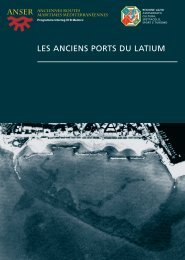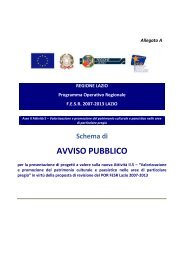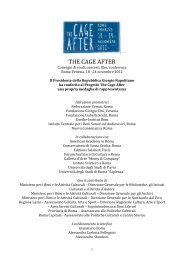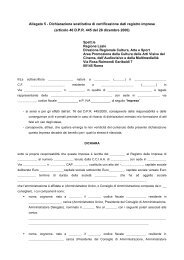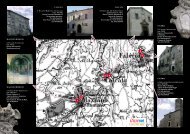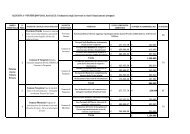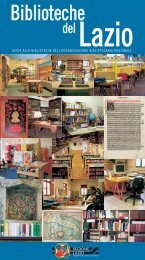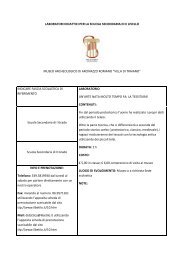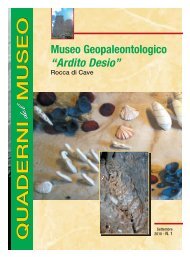scultura - CulturaLazio.it
scultura - CulturaLazio.it
scultura - CulturaLazio.it
You also want an ePaper? Increase the reach of your titles
YUMPU automatically turns print PDFs into web optimized ePapers that Google loves.
Priverno5 20-09-2006 16:09 Pagina 1<br />
<strong>it</strong>inerariculturali<br />
Tirocini e valorizzazione del terr<strong>it</strong>orio<br />
Il progetto Tirocini e stages formativi e di ricerca ha preso avvio nel 2000 con una serie di convenzioni attivate tra<br />
atenei del Lazio e la Direzione Regionale Beni e Attiv<strong>it</strong>à Culturali, Sport della Regione Lazio; è coordinato dall’Area<br />
Valorizzazione del Terr<strong>it</strong>orio e del Patrimonio Culturale e vede la partecipazione anche dell’Area Musei, Archivi e<br />
Biblioteche. Fin dagli esordi si è dimostrato una concreta risposta alle esigenze formative degli studenti delle Scuole di<br />
specializzazione e dei corsi di laurea, e un orientamento per le successive scelte professionali attraverso la<br />
sperimentazione diretta del mondo del lavoro che opera – come è proprio della programmazione culturale della<br />
Regione Lazio – attuando le iniziative di conoscenza e valorizzazione del terr<strong>it</strong>orio.<br />
Gli Itinerari culturali. Tirocini e valorizzazione del terr<strong>it</strong>orio sono la più recente esperienza di tirocinio per la storia<br />
dell’arte. Nel 2004-2005, partendo dal presupposto che la catalogazione è la base imprescindibile per qualsiasi<br />
intervento culturale sul terr<strong>it</strong>orio, con le Univers<strong>it</strong>à “La Sapienza”, “Roma Tre” e la Tuscia sono stati scelti alcuni<br />
comprensori del tutto o in parte schedati per realizzare percorsi al di fuori dei circu<strong>it</strong>i turistici più frequentati del<br />
Lazio, appropriati alla collaborazione tra mondo accademico ed ist<strong>it</strong>uzionale: Collevecchio, Mazzano, Faleria, Calcata<br />
e Terracina. Con la attiva partecipazione dei Comuni interessati e, per Terracina, della Diocesi sono stati realizzati<br />
pannelli fissi e mobili con informazioni sintetiche e una selezione di notizie e immagini di ciò che è scomparso,<br />
modificato, o non più visibile.<br />
Un nuovo gruppo di studenti de “La Sapienza” e di “Roma Tre” è stato impegnato in questo anno accademico nella<br />
realizzazione di depliant con <strong>it</strong>inerari tematici, più adatti della cartellonistica a ‘percorrere’ il terr<strong>it</strong>orio. Riguardano la<br />
Priverno medievale, e il suo risentire e discostarsi dal cantiere della vicina Abbazia di Fossanova, e la Sermoneta civile<br />
e religiosa che originariamente osp<strong>it</strong>ava le opere artistiche oggi nel Museo diocesano.<br />
Sulle tracce di Fossanova. Priverno è la prima di tre tappe scelte per segnalare e collegare episodi di arch<strong>it</strong>etture e sculture<br />
vicine a Fossanova, derivanti dall’Abbazia, o coevi ma del tutto avulsi dalla presenza ‘ingombrante’ e innovativa del cantiere<br />
cistercense. Le successive, nelle province di Latina e Frosinone, toccheranno Valvisciolo e Amaseno, e si concluderanno a<br />
Fossanova nel 2008, nell’ottavo centenario della consacrazione della chiesa abbaziale.<br />
I cinque Itinerari, un po’ di nicchia, si snodano nella Priverno medievale per individuarne la struttura: Priverno. La c<strong>it</strong>tà<br />
medievale; per una caccia ad arch<strong>it</strong>etture e sculture poco visibili, reimpiegate e inglobate in edifici successivi: Priverno.<br />
Arch<strong>it</strong>ettura e Priverno. Scultura; alla ricerca di part<strong>it</strong>ure arch<strong>it</strong>ettoniche e singoli elementi scultorei nel Duomo e nel Palazzo<br />
comunale: Priverno. Il Duomo e Priverno. Il Palazzo Comunale.<br />
The Apprenticeships and training and research project started in 2000 w<strong>it</strong>h agreements set up between the univers<strong>it</strong>ies of<br />
Lazio and the Regional Fine Arts Culture and Sports Administration for Regione Lazio. It is co-ordinated by the<br />
Development of the Terr<strong>it</strong>ory and Cultural Her<strong>it</strong>age Dept and also involves the Museums, Archives and Libraries Dept.<br />
The move has proved a concrete answer to the training requirements of graduate and post-graduate students and a source of<br />
orientation for career choices offering hands-on experience in the world of work and – as is proper to the Regione Lazio’s<br />
cultural programme – organising ways of exploring and developing the area.<br />
Cultural Itineraries. Apprenticeship and development of the terr<strong>it</strong>ory are the latest training courses as regards History of<br />
Art. Based on the principle that cataloguing is the essential starting point for any cultural intervention in the area, in 2004-<br />
2005 the Inst<strong>it</strong>utions, and Univers<strong>it</strong>ies “La Sapienza”, “Roma Tre” and Tuscia chose areas that had been wholly or partly<br />
catalogued and mapped out <strong>it</strong>ineraries not included in the most commonly frequented tourist circu<strong>it</strong>s in Lazio. These<br />
included Collevecchio, Mazzano, Faleria, Calcata and Terracina. W<strong>it</strong>h active participation from the municipal<strong>it</strong>ies<br />
involved and in the case of Terracina also the Diocese, made permanent and movable panels w<strong>it</strong>h short background histories<br />
and information and pictures of what has disappeared, been changed or is no longer visible.<br />
During this academic year a new group of students from “La Sapienza” and “Roma Tre” has put together thematic <strong>it</strong>inerary<br />
brochures, better su<strong>it</strong>ed to covering the area than posters. These regard medieval Priverno and the way <strong>it</strong> is influenced by but<br />
separate from the s<strong>it</strong>e at the nearby Fossanova abbey, and civil and religious Sermoneta, which once housed the art works<br />
now at the Diocesan museum.<br />
On the tracks of Fossanova. Priverno is the first of three stops chosen to illustrate examples of arch<strong>it</strong>ecture and sculpture near<br />
Fossanova inspired by the abbey or contemporary to <strong>it</strong>, but wholly removed from the cumbersome<br />
and innovative presence of the Cistercian s<strong>it</strong>e. The next ones, in the<br />
N<br />
provinces of Latina and Frosinone, will involve<br />
Valvisciolo and Amaseno. These will terminate at<br />
Fossanova in 2008 during the eighth<br />
centenary of the consecration of the<br />
abbey church.<br />
The five rather specialised Itineraries<br />
examine how medieval Priverno<br />
was structured: Priverno. The<br />
medieval town; in search of l<strong>it</strong>tle<br />
seen arch<strong>it</strong>ecture and sculpture reused<br />
and incorporated into later<br />
buildings: Priverno. Arch<strong>it</strong>ecture<br />
and Priverno. Sculpture; in search of<br />
arch<strong>it</strong>ecture and single pieces of<br />
sculpture in the Duomo and Palazzo<br />
comunale: Priverno. The Duomo and<br />
Priverno. The Palazzo Comunale.<br />
Fossanova<br />
Immagine TerraItaly - © Compagnia Generale Ripreseaeree<br />
Regione Lazio<br />
Comune di Priverno<br />
Univers<strong>it</strong>à degli Studi di Roma<br />
“La Sapienza”<br />
Diocesi di Latina,<br />
Terracina, Sezze, Priverno<br />
Regione Lazio<br />
Assessorato Cultura, Spettacolo e Sport - Assessore Giulia Rodano<br />
Dipartimento Sociale - Direttore Vicario Mario Fior<strong>it</strong>o<br />
Direzione Regionale Beni e Attiv<strong>it</strong>à Culturali, Sport - Direttore Enzo Ciarravano<br />
Area Valorizzazione del Terr<strong>it</strong>orio e del Patrimonio Culturale - Dirigente Flaminia Santarelli<br />
Univers<strong>it</strong>à degli Studi di Roma I “La Sapienza” - Scuola di Specializzazione in Storia dell’Arte Medievale e<br />
Moderna - Direttore Marina Righetti<br />
Progetto Itinerari culturali. Tirocini e valorizzazione del terr<strong>it</strong>orio. Sulle tracce di Fossanova. Priverno<br />
a cura di Anna Pasquetti - Area Valorizzazione del Terr<strong>it</strong>orio e del Patrimonio Culturale<br />
in collaborazione con l’Univers<strong>it</strong>à degli Studi di Roma I “La Sapienza” - Scuola di Specializzazione in Storia<br />
dell’Arte Medievale e Moderna<br />
Tutor per la Regione Lazio: Anna Pasquetti<br />
Tutor per l’Univers<strong>it</strong>à degli Studi di Roma I “La Sapienza”: Marina Righetti e Pio Francesco Pistilli<br />
Elaborazione e revisione delle schede OA di catalogo per la Regione Lazio:<br />
Luca Bortolotti, Ebe Giacometti, Elena Longo - Collaboratori Regione Lazio<br />
Ricerche e testi: Livia Bevilacqua (4. Arch<strong>it</strong>ettura); Benedetta Caporioni (2. Il Duomo);<br />
Roberta Cerone (3. Il Palazzo Comunale); Alessandro Cosma (3. Il Palazzo Comunale);<br />
Paolo Degrandi (5. Scultura); Francesco Gangemi (5. Scultura); Elisabetta Guerriero (1. La c<strong>it</strong>tà medievale);<br />
Gabriele Quaranta (4. Arch<strong>it</strong>ettura); Serena Rossi (1. La c<strong>it</strong>tà medievale) - Scuola di Specializzazione in Storia<br />
dell’Arte Medievale e Moderna dell’Univers<strong>it</strong>à degli Studi di Roma I “La Sapienza”<br />
Si ringraziano: Umberto Macci - Sindaco del Comune di Priverno<br />
S.E.R. Monsignor Giuseppe Petrocchi - Vescovo della Diocesi di Latina, Terracina, Sezze, Priverno<br />
Ferruccio Pantalfini - Diocesi di Latina, Terracina, Sezze, Priverno<br />
Marina Righetti - Direttore della Scuola di Specializzazione in Storia dell’Arte Medievale e Moderna<br />
dell’Univers<strong>it</strong>à degli Studi di Roma I “La Sapienza”<br />
Pio Francesco Pistilli - Scuola di Specializzazione in Storia dell’Arte Medievale e Moderna dell’Univers<strong>it</strong>à degli<br />
Studi di Roma I “La Sapienza”<br />
Monsignor Giovanni Gallinari - Parroco della Cocattedrale di San Giovanni, di San Tommaso<br />
Don Giambattista Ficarola - Parroco di Sant’Antonio, di San Cristoforo e V<strong>it</strong>o<br />
Padre Gregorio - Abbazia di Fossanova<br />
Edmondo Angelini<br />
Giorgia Corso e Iara Giulia Daniele<br />
Referenze fotografiche<br />
Regione Lazio - Area Valorizzazione del Terr<strong>it</strong>orio e del Patrimonio Culturale<br />
Giovanni Angotta per la CO.PA.T.<br />
Giorgia Corso<br />
Iara Giulia Daniele<br />
Area Valorizzazione del Terr<strong>it</strong>orio e del Patrimonio Culturale<br />
00147 Roma, viale del Caravaggio 99<br />
tel 06 51688406-fax 06 51688172<br />
e-mail: apasquetti@regione.lazio.<strong>it</strong><br />
Realizzazione: Palombi & Partner s.r.l.<br />
www.palombied<strong>it</strong>ori.<strong>it</strong><br />
In copertina<br />
Abbazia di Fossanova, chiostro, particolare<br />
<strong>it</strong>inerariculturali<br />
Tirocini e valorizzazione del terr<strong>it</strong>orio<br />
Sulle tracce di Fossanova<br />
<strong>scultura</strong><br />
Priverno<br />
sculpture<br />
5
Priverno5 2-08-2006 14:30 Pagina 2<br />
La <strong>scultura</strong> medievale conservata a Priverno, composta essenzialmente di pezzi frammentari e<br />
decontestualizzati, non manifesta una dipendenza diretta dal grande cantiere dell’Abbazia di<br />
Fossanova. Alcuni esempi di <strong>scultura</strong> strettamente arch<strong>it</strong>ettonica, quali colonnine decorate, cap<strong>it</strong>elli<br />
a crochets ed elementi vegetali, sono però riconducibili al repertorio formale cistercense. L’impronta<br />
fossanoviana si innesta apparentemente su un sostrato romanico di matrice meridionale, sulla cui consistenza<br />
è impossibile esprimersi a causa della distruzione dell’ab<strong>it</strong>ato in segu<strong>it</strong>o all’incendio del 1159. Nelle opere<br />
conservate, quasi tutte risalenti a un periodo compreso tra XIII e XIV secolo, il carattere cistercense e il<br />
gusto arcaizzante convivono e si compenetrano, come nel pulp<strong>it</strong>o dell’Annunziata di Amaseno, realizzato<br />
nel 1291 da una famiglia di scultori privernati, i Gullimari, e nella decorazione del portico del<br />
Duomo di Priverno. Le sculture qui prese in esame cost<strong>it</strong>uiscono una selezione di pezzi in<br />
grado di mostrare, attraverso un <strong>it</strong>inerario all’interno della c<strong>it</strong>tà, le diverse sfumature di questa<br />
ambivalenza culturale, esplicate da differenti tipologie scultoree.<br />
[F. G.]<br />
Arch<strong>it</strong>rave di Sant’Antonio Abate<br />
L’arch<strong>it</strong>rave di Sant’Antonio Abate mostra una certa indifferenza agli stimoli della <strong>scultura</strong> fossanoviana,<br />
riallacciandosi piuttosto a un repertorio romanico dagli accenti meridionali, che denuncia un robusto<br />
grado di arcaismo se si considera la data (1336) scolp<strong>it</strong>a alla base del pezzo [1]. L’iscrizione tramanda<br />
anche il nome dell’autore, Toballo de Ianni, e sollec<strong>it</strong>a un’analoga cronologia per l’arch<strong>it</strong>rave della chiesa<br />
dell’Annunziata a Terracina, privo di data, ma firmato da un Andreas de Piperno [2]. Quest’ultimo nome<br />
indica chiaramente l’esecuzione di entrambe le sculture, la cui sigla distintiva è il tralcio di v<strong>it</strong>e intrecciato<br />
e originato dal becco di due volatili, da parte di maestranze locali, che ancora in pieno XIV secolo<br />
proponevano una rivis<strong>it</strong>azione del tema dell’archivolto maggiore dell’atrio del Duomo privernate,<br />
databile entro la metà del Duecento.<br />
[F. G.]<br />
The medieval sculptures at Priverno, essentially composed of fragmented and de-contextualised pieces, do not show<br />
direct reliance on the great Fossanova Abbey s<strong>it</strong>e. Some examples of sculpture w<strong>it</strong>h strictly arch<strong>it</strong>ectural qual<strong>it</strong>ies,<br />
such as small decorated columns, crochets cap<strong>it</strong>als and plant motifs, can however be traced back to the formal<br />
Cistercian repertoire. The Fossanova style would appear to be grafted on to a Romanesque lower layer of southern<br />
origin. However <strong>it</strong> is impossible to gauge to what degree this is so since the town was destroyed by fire in 1159. In<br />
the works conserved, almost all dating from between the 13 th and 14 th centuries, the Cistercian nature and archaising<br />
taste co-hab<strong>it</strong> and interact, as we see from the pulp<strong>it</strong> in the Annunziata church at Amaseno built in 1291 by the<br />
Gullimari, a family of Priverno sculptors. The same can be said for the decoration on the portico at Priverno<br />
Cathedral. The sculptures examined here represent a cross-section of pieces showing the varying degrees of this cultural<br />
ambivalence through the diverse sculptural types in the town.<br />
[F. G.]<br />
The arch<strong>it</strong>rave at Sant’Antonio Abate<br />
The arch<strong>it</strong>rave at Sant’Antonio Abate shows a certain indifference to the stimuli of Fossanovan sculpture, referring<br />
rather to a Romanesque repertoire w<strong>it</strong>h southern tones that reveals a strong degree of archaism considering the date<br />
(1336) sculpted at the base of the piece [1]. The inscription tells us the name of the creator, Toballo de Ianni, and<br />
prompts a similar chronology for the<br />
arch<strong>it</strong>rave at the Annunziata church<br />
at Terracina, undated but signed by<br />
Andreas de Piperno [2]. The latter<br />
name clearly indicates the execution of<br />
both sculptures. His mark of distinction is the intertwined vine-shoot that originates from the beaks of two birds<br />
made by local workmen, who in the middle of the 14 th century were still proposing a version of the main archivolt<br />
in the atrium of Priverno Cathedral, datable before the middle of the 13 th century.<br />
[F. G.]<br />
Zoomorphic heads at 1 via Zaccaleoni<br />
The two monkeys placed oppos<strong>it</strong>e one another are holding a small anthropomorphic head in their back paws [3]. The<br />
sculpture is hewn from a single block of stone. Judging from <strong>it</strong>s style <strong>it</strong> can be dated between the 13 th and 14 th century<br />
and attributed to the Priverno workers. In medieval iconography the monkey is a symbol of sin. The piece, originally<br />
[2]<br />
[1]<br />
Protomi zoomorfe in via Zaccaleoni 1<br />
Le due scimmie, in posizione speculare, reggono negli arti inferiori una testina antropomorfa [3].<br />
La <strong>scultura</strong> è ricavata da un unico blocco di pietra. Su base stilistica è ipotizzabile un’esecuzione<br />
tra il XIII ed il XIV secolo ad opera di maestranze privernati. Nell’iconografia medievale la<br />
scimmia è simbolo del peccato. Il pezzo, originariamente pertinente alla decorazione di un<br />
edificio non identificabile, fu riutilizzato, verosimilmente agli inizi del XX secolo, nella<br />
facciata della casa, secondo una pratica piuttosto diffusa a Priverno.<br />
[P. D.]<br />
Testina umana in via Leone Leo 12<br />
Questa curiosa <strong>scultura</strong> [4] si trova incassata in una nicchia sulla facciata di un’ab<strong>it</strong>azione di<br />
origine medievale, dove è stata collocata, con funzioni ornamentali, insieme a una delle coppie<br />
di leoni che scandiscono ogni percorso tra le vie e i palazzi di Priverno. Si tratta di una testa<br />
umana che presenta caratteri piuttosto singolari, come la rigida acconciatura conclusa da<br />
coppie di boccoli simmetrici, il sorriso accennato e tuttavia non propriamente discreto, e la<br />
[3]<br />
florida stilizzazione del volto, che presuppone la rappresentazione di un tipo umano precisamente<br />
pingue. La <strong>scultura</strong> è conclusa in alto da un elemento forato, non chiaramente interpretabile<br />
come copricapo ma forse come membro d’imposta, che farebbe della testina una struttura di<br />
sostegno. L’eccentric<strong>it</strong>à del pezzo e il suo stato decontestualizzato ne rendono difficoltosa ogni<br />
ipotetica datazione, tuttavia è possibile scorgere nella <strong>scultura</strong> tracce del gusto classicistico duecentesco,<br />
applicate a un pezzo probabilmente non anteriore alla prima metà del XIV secolo.<br />
[F. G.]<br />
Coppia di protomi leonine in via Leone Leo 40<br />
In molte c<strong>it</strong>tà <strong>it</strong>aliane la rappresentazione scultorea del leone, isolato o in coppia, viene imposta sui punti<br />
più rappresentativi come negli angoli più remoti, con significati che vanno dalla protezione alla giustizia,<br />
alla nobiltà, e Priverno in questo non fa eccezione. L’abbondante diffusione di sculture leonine in tutta la<br />
c<strong>it</strong>tà, anzi, è stata messa in relazione con la figura del fondatore dell’ab<strong>it</strong>ato medievale, Leone Leo, i cui<br />
riflessi sarebbero da rintracciarsi anche nella toponomastica stradale (ad esempio, via Zaccaleoni). Questo<br />
naturalmente può considerarsi l’elemento rafforzativo più che quello determinante di una tradizione ben<br />
diffusa e attestata altrove fin dall’antich<strong>it</strong>à. La coppia di sculture scelta come esempio [5]<br />
indica un altro carattere dei rilievi privernati, la decontestualizzazione: i due leoni, infatti,<br />
belonging to the decoration of an unidentifiable building was probably reused at the beginning<br />
of the 20 th century on the façade of the house, as was fairly common practice at Priverno.<br />
[P. D.]<br />
Small human head at 12 via Leone Leo<br />
This curious sculpture [4] is embedded in an alcove on the façade of a medieval house, where <strong>it</strong><br />
was placed as ornamentation together w<strong>it</strong>h one of the pairs of lions that appear along all the streets<br />
and on the palazzi at Priverno. It is a human head w<strong>it</strong>h unusual tra<strong>it</strong>s, such as the stiff hairstyle ending in pairs of<br />
symmetrical curls, a slight yet open smile, and a florid, stylised face suggesting a rather corpulent person. At the top, the<br />
sculpture has a pierced element, perhaps a headdress or part of the impost block, which would make the head a supporting<br />
feature. The eccentric<strong>it</strong>y of the piece and <strong>it</strong>s de-contextualisation make <strong>it</strong> very hard to date, however <strong>it</strong> does show traces<br />
of 13th century classicist taste applied to a piece that is in all likelihood no earlier than the first half of the 14th [4]<br />
century.<br />
[F. G.]<br />
[6]<br />
Pairs of lion heads at 40 via Leone Leo<br />
In many Italian towns the sculpted lion, alone or in a pair, is placed in the most representative<br />
areas just as frequently as in the remotest corners, w<strong>it</strong>h meanings that range from protection<br />
to justice or nobil<strong>it</strong>y; Priverno is no exception in this. The abundance of lion sculptures<br />
all over the town has been connected to the founder of the medieval settlement,<br />
Leone Leo, whose named is also referred to in the street names (via Zaccaleoni,<br />
for example). This is to be considered an element of reinforcement rather than a<br />
decisive one in a trad<strong>it</strong>ion commonly found elsewhere since ancient times. The pair<br />
chosen as an example [5] indicate another feature in the Priverno sculptures, their decontextualisation:<br />
the two lions are today embedded in the impost block of a window,<br />
but they probably once belonged to a religious building, as is the case of the animal<br />
sculptures in the porch of the Cathedral and on some of the pulp<strong>it</strong>s . The fact that the two<br />
figures are still placed in front of one another suggests that their original function was to<br />
guard the entrance of an important building, while the geometric modelling of the mane<br />
and faces may suggest a date around the end of the 13 th and start of the 14 th century.<br />
[F. G.]<br />
appaiono oggi incassati negli stip<strong>it</strong>i di una finestra, ma è probabile la loro originaria<br />
pertinenza a un edificio religioso, come nel caso degli animali stilofori del portico del<br />
Duomo e di alcuni pulp<strong>it</strong>i. Il fatto che le due sculture si presentano ancora oggi affrontate<br />
suggerisce una loro antica funzione di presidio all’ingresso di qualche struttura significativa,<br />
mentre il modellato geometrico delle criniere e dei volti può indicare una datazione a<br />
cavallo tra XIII e XIV secolo.<br />
[F. G.]<br />
Cap<strong>it</strong>elli del presb<strong>it</strong>erio di San Tommaso<br />
I quattro cap<strong>it</strong>elli sono stilisticamente databili verso la fine del XIII secolo [6]. I crochets<br />
[5]<br />
rivelano un’originale reinterpretazione in chiave calligrafico-ornamentale del tipo rappresentato<br />
dai cap<strong>it</strong>elli del lato meridionale del chiostro e di quelli della sala cap<strong>it</strong>olare dell’Abbazia di<br />
Fossanova [vedi immagine in copertina], verosimilmente presi a modello dalle maestranze privernati. Ulteriori<br />
confronti sono possibili con i cap<strong>it</strong>elli dell’arco trasversale della chiesa di Sant’Antonio Abate a Priverno, anch’essi<br />
in parte tributari del modello fossanoviano.<br />
[P. D.]<br />
Crocetta di San Giovanni<br />
Documentata a partire dal 1818, è stata realizzata in epoca imprecisata assemblando vari materiali scultorei<br />
di reimpiego [7]. Un documento tardo-ottocentesco attesta l’utilizzo di elementi dell’arredo della chiesa di<br />
San Giovanni Evangelista. Secondo Angelini la maggior parte dei pezzi, dal carattere decisamente romanico,<br />
avrebbe fatto parte dello smembrato pulp<strong>it</strong>o (XII-XIII secolo), opera di maestranze privernati. Le colonnine,<br />
delle quali una tortile, ed i fregi decorativi della grande base quadrangolare ne avrebbero cost<strong>it</strong>u<strong>it</strong>o la parte<br />
superiore. Al pulp<strong>it</strong>o sono da ricondursi due delle quattro protomi zoomorfe, rappresentanti dei leoni, poste<br />
alla base del fusto della grande colonna. Nell’iconografia medievale il leone isolato è simbolo della Resurrezione.<br />
Al contrario è da escludere l’appartenenza al pulp<strong>it</strong>o delle due protomi, raffiguranti una leonessa (?) ed un<br />
cavallo, che rivelano una maniera decisamente più arcaica. I due cap<strong>it</strong>elli fogliati a crochets posti a sostegno e<br />
a coronamento della grande colonna, per i quali è ipotizzabile la provenienza da un diverso e non precisabile<br />
contesto, presentano legami stilistici con i cap<strong>it</strong>elli duecenteschi del lato meridionale del chiostro<br />
dell’Abbazia di Fossanova. Secondo l’Enlart la Crocetta di San Giovanni sarebbe stata concep<strong>it</strong>a<br />
quale Calvario monumentale.<br />
[P. D.]<br />
Cap<strong>it</strong>als in the San Tommaso presbytery<br />
The four cap<strong>it</strong>als are stylistically datable to around the end of the 13 th century [6]. The crochets reveal an<br />
original re-interpretation in an ornamental-calligraphic style of the type seen on the cap<strong>it</strong>als on the southern<br />
side of the cloister and those in the cap<strong>it</strong>ular hall at Fossanova Abbey, most probably used as a model by the<br />
Priverno workmen [see figure on the cover]. Further comparisons can be made w<strong>it</strong>h the cap<strong>it</strong>als on the<br />
transverse arch of the church of Sant’Antonio Abate at Priverno, also partly derived from the Fossanova model.<br />
[P. D.]<br />
The San Giovanni Cross<br />
Documented after 1818, <strong>it</strong> was made at an uncertain date by assembling a variety of used sculptural materials<br />
[7]. A late 19 th century document mentions elements from the furnishings of the San Giovanni Evangelista<br />
church. According to Angelini most of the pieces, clearly Romanesque, were part of the pulp<strong>it</strong> made by Priverno<br />
Per saperne di più<br />
C. ENLART, Origines françaises de l’arch<strong>it</strong>ecture<br />
gothique en Italie, Paris-Thorin 1894, p. 153<br />
E. ANGELINI, La decorazione scultorea nei<br />
monumenti privernati, in Studi privernati,<br />
Priverno 1973<br />
E. BASSAN, s.v. Andrea da Priverno, in<br />
Enciclopedia dell’Arte Medievale, I, Roma 1991,<br />
pp. 620-621<br />
E. ANGELINI, I lapicidi privernati dal XII al XIV<br />
secolo, in Uomo e società: arte, mestieri, professioni<br />
(Atti del II Convegno di Studi storici sul terr<strong>it</strong>orio<br />
della Provincia, Latina, 11-12 dicembre 1992),<br />
Latina 1992, pp. 91-114<br />
E. ANGELINI, Priverno nel Medioevo, II, Roma<br />
1998, pp. 436 ss.<br />
Referenze fotografiche<br />
Fig. 2. Foto I. G. Daniele<br />
Veduta Aerea: Immagini TerraItaly - ©<br />
Compagnia Generale Ripreseaeree S.p.A. - Parma<br />
www.terra<strong>it</strong>aly.<strong>it</strong><br />
workmen that was taken apart (12 th -13 th century).<br />
The small columns, one a spiral, and the<br />
decorative frieze of the large quadrangular<br />
base made up the upper part. Also part of the<br />
pulp<strong>it</strong> were the two of the four zoomorphic<br />
heads representing lions at the base of the<br />
large column shaft. In medieval iconography<br />
the single lion is a symbol of the Resurrection.<br />
Not parts of the pulp<strong>it</strong> instead were the two<br />
animal heads of a lioness (?) and a horse, which<br />
are far more archaic in style. The two foil cap<strong>it</strong>als<br />
w<strong>it</strong>h crochets supporting and crowning the<br />
large column, of uncertain but different origin,<br />
are stylistically linked to the 13 th century cap<strong>it</strong>als<br />
on the south side of the Fossanova Abbey<br />
cloisters. In Enlart’s view the San Giovanni<br />
Cross was conceived as a monumental Calvary.<br />
[P. D.]<br />
[7]



